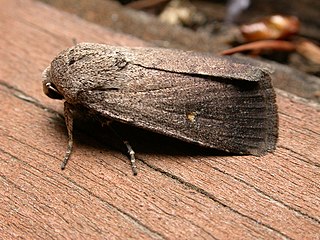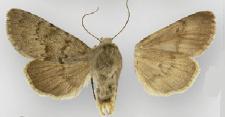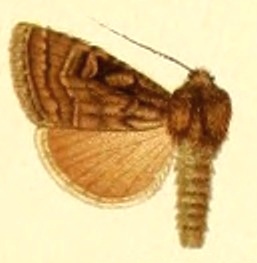
Xestia is a genus of noctuid moths. They are the type genus of the tribe Xestiini in subfamily Noctuinae, though some authors merge this tribe with the Noctuini. Species in this genus are commonly known as "clays", "darts" or "rustics", but such names are commonplace among Noctuidae. Xestia moths have a wide distribution, though they most prominently occur in the Holarctic.

Eugraphe is a genus of noctuid moths. They belong to the tribe Xestiini of the typical noctuid subfamily Noctuinae, though some do not separate this tribe and include the genus in the Noctuini. It is closely related to Anagnorisma, Coenophila and Eugnorisma, and as it seems most closely to the first of these. The geographic range is Palearctic, north of the Alpides but including the Caucasus, and between the Arctic and the arid lands of Central Asia.

Proteuxoa is a genus of moths of the family Noctuidae. The genus was erected by George Hampson in 1903.

Eueretagrotis perattentus, the two-spot dart, is a moth of the family Noctuidae. It is found from coast to coast across central and southern Canada, and in the northern United States, south along the Appalachians to western North Carolina and Tennessee. There are a few scattered records along the Rocky Mountains from south-western Montana to south-eastern Arizona.

Euxoa adumbrata, the sordid dart, is a moth of the family Noctuidae. The species was first described by Eduard Friedrich Eversmann in 1842. In North America it is found across northern Canada from Quebec to western Alaska, south to the northern parts of the United States, and in the mountains to Colorado. It is also found in Greenland, the coastal areas of Scandinavia and the Ural. It was recently recorded from Denmark, although this includes Euxoa lidia, which some authors regard to be a valid species.

Lasionycta promulsa is a moth of the family Noctuidae. It occurs from Rampart House in northern Yukon to south-western British Columbia in the west and southern New Mexico in the Rocky Mountains.

Goniographa is a genus of noctuid moths. They belong to the tribe Xestiini of the typical noctuid subfamily Noctuinae, though some do not separate this tribe and include the genus in the Noctuini.

Goniographa marcida is a moth of the family Noctuidae. It is found endemic to the Kopet-Dagh mountain system in Turkmenistan and Iran.
Goniographa gyulaipeteri is a moth of the family Noctuidae. It is widely distributed in the western Tien-Shan Mountains, in the Hissar and Alai Mountains, in the western Pamirs and also in north-eastern Afghanistan (Badakhshan).
Goniographa decussa is a moth of the family Noctuidae. It is found in the western Tien-Shan Mountains.
Goniographa discussa is a moth of the family Noctuidae. It is found from the Zeravshan Mountains and Hissar Mountains through the western Pamirs to north-eastern Afghanistan (Badakhshan).
Goniographa shchetkini is a moth of the family Noctuidae. It is only known from a single location near the Liangar Glacier.
Goniographa metafunkei is a moth of the family Noctuidae. It has a strictly limited distribution in the western part of the Tien-Shan Mountains and the Alai Mountains.
Goniographa naumanni is a moth of the family Noctuidae. It is confined to the Hissar Mountains, the western Pamirs and the north-eastern territories of Afghanistan.
Xestia ornata is a moth of the family Noctuidae. It is found from the northern Tien-Shan Mountains through the Pamirs and Hissar-Darwaz system to eastern Afghanistan (Nuristan).
Xestia hypographa is a moth of the family Noctuidae. It is only known from the north-western part of the Tien-Shan Mountains.

Dichagyris orientis is a moth of the family Noctuidae. It is found from Croatia, south to Macedonia, east to Romania, Ukraine and Russia and further east to central Asia, Turkestan, south-western Siberia, the Caucasus, Armenia, Turkey, Iran, western China and Mongolia.
Proteuxoa goniographa is a moth of the family Noctuidae. It is found in Queensland.

Eugraphe sigma is a moth of the family Noctuidae. It is found from most of Europe to the Ural, Siberia, Transcaucasia, Armenia and Korea.
This page is based on this
Wikipedia article Text is available under the
CC BY-SA 4.0 license; additional terms may apply.
Images, videos and audio are available under their respective licenses.









